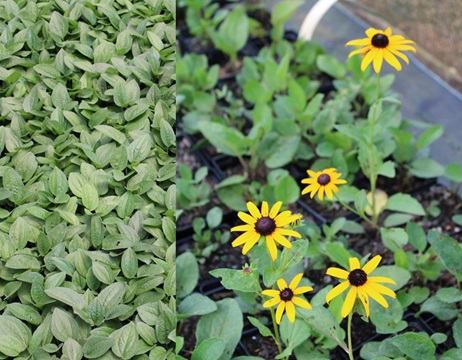Shop by Category
Shop by Brand
Shop by Brand
Rudbeckia
Long-Blooming, Pollinator-Friendly, Award-Winning
- Exceptionally Long Bloom Time: This is one of its standout features. It reliably produces masses of cheerful, daisy-like yellow flowers with dark brown centers from mid-summer often right through to the first frosts in fall, providing months of color when many other perennials are fading.
- Low Maintenance & Easy to Grow: It is a forgiving plant, tolerant of a range of conditions once established. It does not require fussy care, making it great for beginners or busy gardeners.
- Attracts Pollinators: The flowers are a magnet for bees, butterflies, and other beneficial insects, making it an excellent choice for wildlife or pollinator gardens.
- Drought Tolerant: Once established, Rudbeckia fulgida holds up well in dry conditions, though consistent moisture yields the best flowering.
- Deer and Rabbit Resistant: Generally, deer and rabbits tend to leave it alone, which is a huge plus in many areas (including Milton, GA).
- Versatile in the Landscape: It works well in borders, mass plantings, cottage gardens, native plant gardens, meadows, and containers. It also makes a great cut flower.
- Reliable Performance: It is known for being a sturdy and dependable performer year after year. Cultivars like 'Goldsturm' are Perennial Plant Association Plant of the Year award winners, highlighting their garden value.
- Good Structure: Even when not in bloom, the foliage forms an attractive clump. Dried seed heads can provide winter interest and food for birds like goldfinches.
- Sunlight: Plant in full sun (6+ hours of direct sunlight per day) for the best flowering and sturdiest growth. It can tolerate light shade, but flowering may be reduced, and stems might become leggier.
- Soil: Adaptable to various soil types, including clay, as long as it is reasonably well-drained. It prefers average garden soil. Avoid overly rich or constantly wet soils, which can lead to floppy growth or root rot.
- Planting Time: Plant container-grown plants in spring or early fall. Planting in fall allows roots to establish before winter. Spring planting is also fine, just ensure adequate watering during the first summer.
- Spacing: Space plants about 18-24 inches apart to allow for mature spread and ensure good air circulation, which helps prevent fungal diseases. Cultivars like 'Goldsturm' will spread by rhizomes to form substantial clumps.
- Watering: Water regularly and deeply after planting until the plant is well-established (usually the first growing season). Once established, it is relatively drought-tolerant but performs best with consistent moisture, especially during bloom and prolonged dry spells. Avoid overhead watering late in the day to minimize disease risk.
- Fertilizing: Generally, Rudbeckia fulgida does not require heavy fertilization. Amending the soil with compost at planting time is usually sufficient. If growth seems weak, a light application of a balanced slow-release fertilizer in spring can be used, but avoid over-fertilizing, which promotes weak, floppy growth.
- Maintenance:
- Deadheading (Optional): Removing spent flowers can encourage slightly more blooming and tidies the plant's appearance. However, leaving the seed heads provides food for birds (especially goldfinches) and adds winter interest.
- Cut Back: Cut the stems back to the ground in late fall after a hard frost or in early spring before new growth emerges.
- Pests and Diseases: Relatively trouble-free. Potential issues include:
- Powdery Mildew: White coating on leaves, especially in humid conditions or shade with poor air circulation. Ensure good spacing.
- Septoria Leaf Spot: Fungal spots on lower leaves, often progressing upwards. Remove affected leaves promptly and clean up debris in the fall. Improve air circulation.
- Aphids or spider mites are occasionally possible but rarely cause significant damage.
- Division: To manage spread and rejuvenate clumps, divide Rudbeckia fulgida every 3-4 years in the spring as new growth begins to emerge. Dig up the clump, separate it into smaller sections (each with roots and shoots), and replant.
- Climate Suitability: Rudbeckia fulgida tolerance for heat and humidity, coupled with relative drought tolerance once established, makes it a reliable choice. Ensure good drainage and air circulation to combat potential fungal issues common in humid summers.
By following these guidelines, you can enjoy the vibrant, long-lasting blooms of Rudbeckia fulgida in your garden for many years.
 Rudeckia (rud-bek-ee-uh) coneflower, black-eye susan, brown-eye susan; Asteraceae Family. Annual, biennial and perennial plants, Rudeckia are native to North America. Though coarse in habit, they are sturdy and especially useful for their August and September bloom. Good in the border, the wild garden or the cutting garden. All the species have raised, cone-like, dark centers, and some have two colored petals.
Rudeckia (rud-bek-ee-uh) coneflower, black-eye susan, brown-eye susan; Asteraceae Family. Annual, biennial and perennial plants, Rudeckia are native to North America. Though coarse in habit, they are sturdy and especially useful for their August and September bloom. Good in the border, the wild garden or the cutting garden. All the species have raised, cone-like, dark centers, and some have two colored petals.
Rudbeckias are easily grown in average, dry to medium, well-drained soils. For the most blooms, plants prefer full sun and consistent moisture, though established plants have some drought tolerance. Remove spent flowers to encourage additional bloom. Rudbeckias are very easy to divide in the spring.
Attributes: Border plants, Container, Cut flower, Mass Planting, Easy to grow. Attracts butterflies and songbirds.
